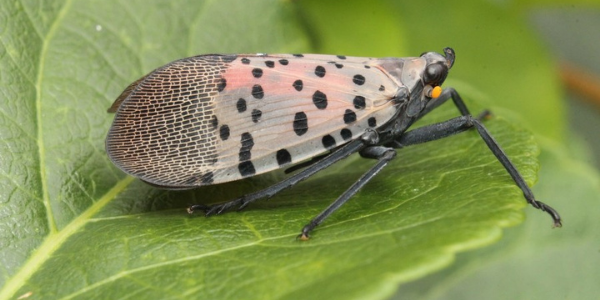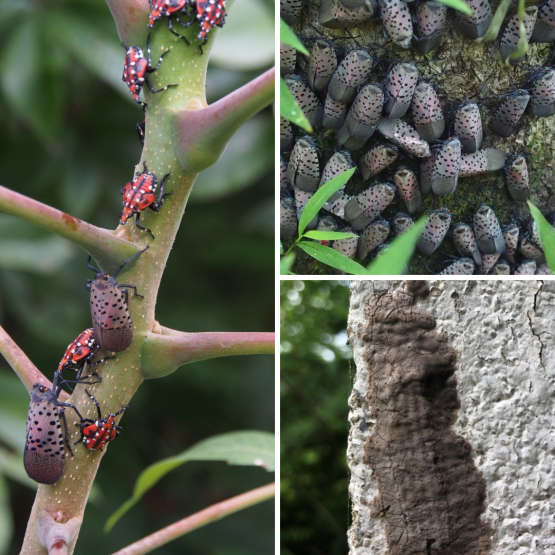
QUICK SUMMARY
- Any spotted lanternflies you detect should be killed immediately, as they can cause serious damage to home and commercial gardens.
- Peach, apple, grape and wine industries in Virginia are threatened most by the spotted lanternfly.
- There are no current infestations or quarantine in Fairfax County, but there are recent confirmed sightings in Loudoun and Prince William counties.
(Updated Aug. 8, 2022)
The spotted lanternfly is on most wanted lists around the world -- and now in Fairfax County.
This pest, originally native to areas of Southeast Asia, is being found in locations throughout the United States, including Virginia since 2018. Its food supply consists of more than 70 plant species, including grapes, hops, apples, stone fruits, and tree-of-heaven, its preferred host. The peach, apple, grape and wine industries in Virginia are threatened most by the spotted lanternfly.
WHERE HAVE LANTERFLIES BEEN SPOTTED?
While there are still no sightings of the spotted lanternfly in Fairfax County, it is getting closer, and experts are on the lookout for it.
Surrounding counties have confirmed sightings, including Loudoun County and Prince William County. There are currently 22 quarantines in place across the Commonwealth of Virginia. Businesses in the quarantined areas are required to obtain state permits and inspect regulated articles to ensure that these articles do not contain any life stage of the spotted lanternfly.
The spotted lanternfly is getting closer to @fairfaxcounty! Help protect the commonwealth's agricultural industry. Report sightings to ReportSLF@fairfaxcounty.gov or call 703-324-5304. Learn more: https://t.co/GBnVgLR3pB#SeeSomethingSaySomething #InvasivePests #SpottedLanternfly pic.twitter.com/5KayaJCZFp
— Fairfax County Public Works (@ffxpublicworks) August 8, 2022
WHAT DO THEY LOOK LIKE?
They are different colors at the four different nymph stages. For example, there are black and white nymphs; red, black and white nymphs; and adults. Adult lanternflies have gray-brown forewings, a black head and black spots. When at rest the hind wings, which are crimson in color, can be partially seen through the semi-translucent forewings, which gives the lanternfly a reddish cast. The lanternfly’s abdomen is yellow with black and white bands on the tip and bottom.

WHEN DO THEY LAY EGGS?
Adults begin laying eggs in September and through the first few hard frosts. The egg masses are covered in a light gray colored wax that looks like mud when it dries.
WATCH
WHAT SHOULD I DO IF I SEE SPOTTED LANTERNFLIES?
Any spotted lanternflies you detect should be killed immediately, as they can cause serious damage to home and commercial gardens. There are various ways to destroy the pest, depending on the time of year:
- From September thru July the egg masses can be scraped from items or trees and the trunks covered with adhesive bands. Scrapings should be directed into containers of rubbing alcohol or hand sanitizer.
- From mid-May through August insecticide can be utilized on the tree-of-heaven, where the pest primarily feeds.
- Throughout the remainder of the year stump treatments, hack and squirt treatments, foliar sprays, basal bark sprays, as well as tree-of-heaven treatments may be effective.
Spotted lanternflies feed on plant sap and excrete a sticky substance called ‘honeydew,’ which attracts wasps and ants. The honeydew also encourages “sooty mold” growth on plants and trees. This black mold can cover leaf surfaces, stunt plant growth, and together with the insect feeding damage, ruin crops.
Report sightings to ReportSLF@fairfaxcounty.gov or call 703-324-5304.
WHERE WILL THEY BE FOUND?
While they are known travelers, or “hitchikers” you may find them on items such as wood, plant and landscape materials, trees, rocks, vehicles and many other items stored outdoors.
WATCH WEBINAR
FOR MORE INFORMATION
To learn more, or if you have questions, contact our Urban Forest Management Division Forest Pest Management Branch at 703-324-1770 or via email at pestmail@fairfaxcounty.gov.



 SIGN UP FOR DAILY EMAIL HEADLINES
SIGN UP FOR DAILY EMAIL HEADLINES